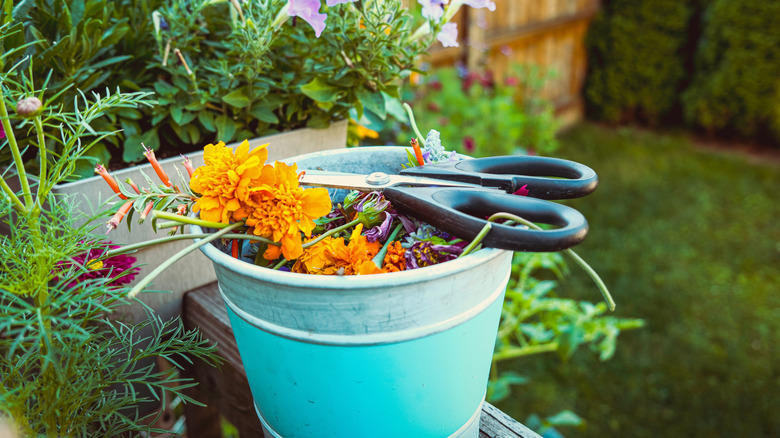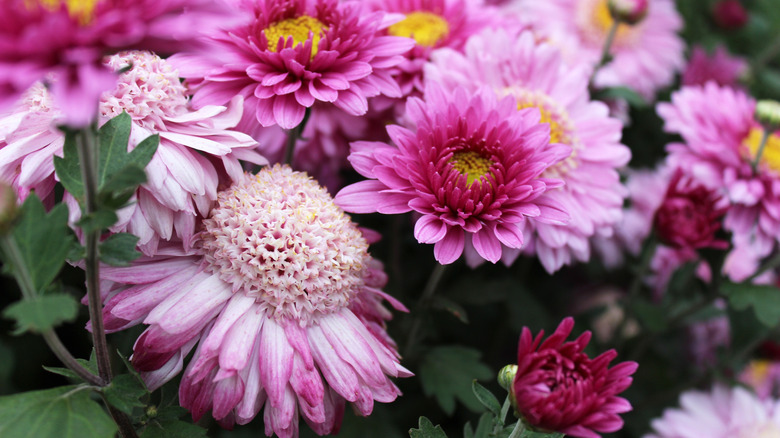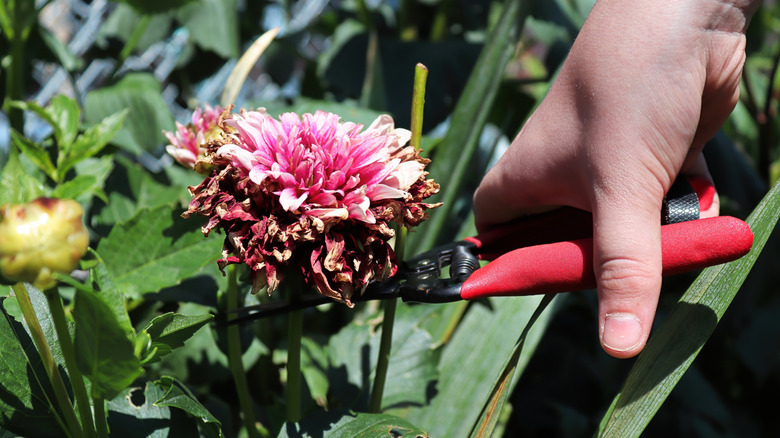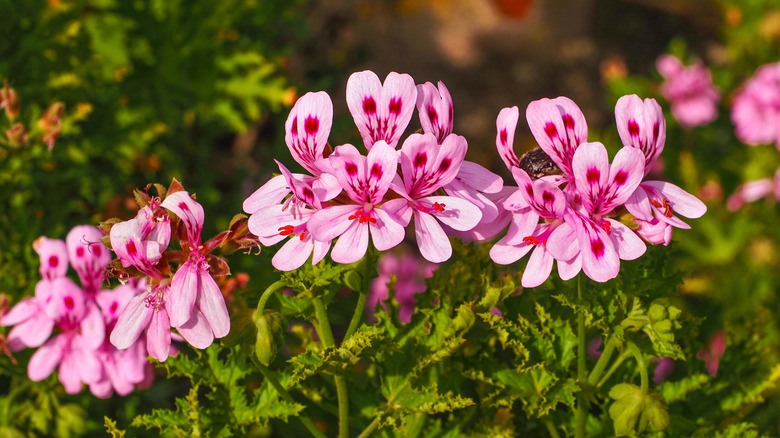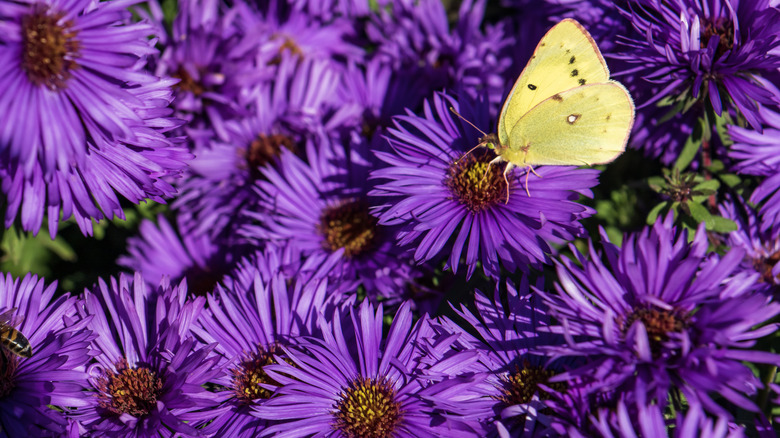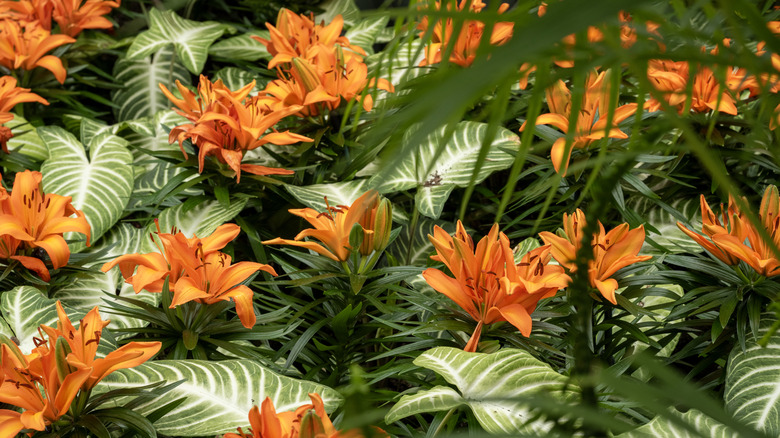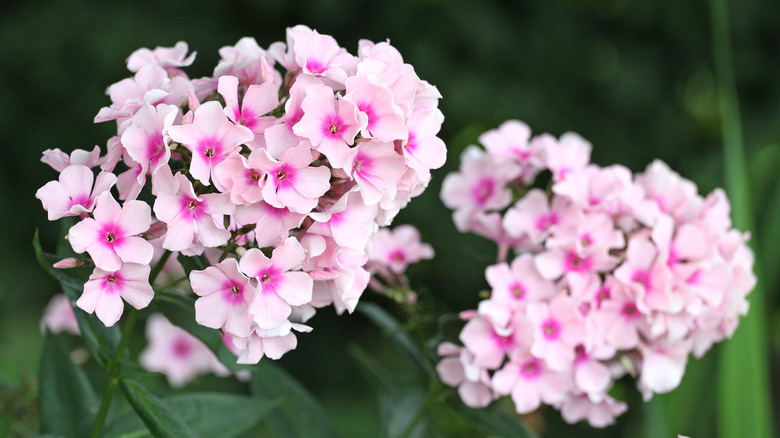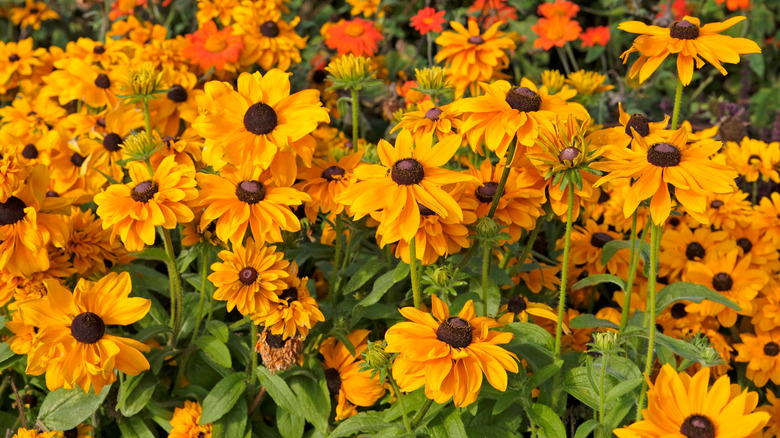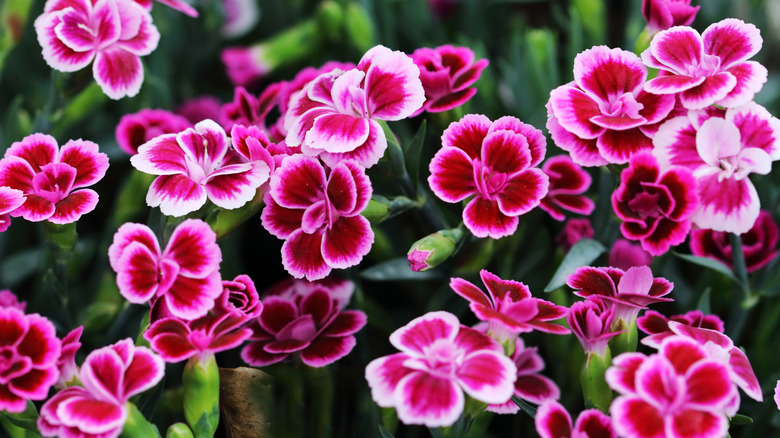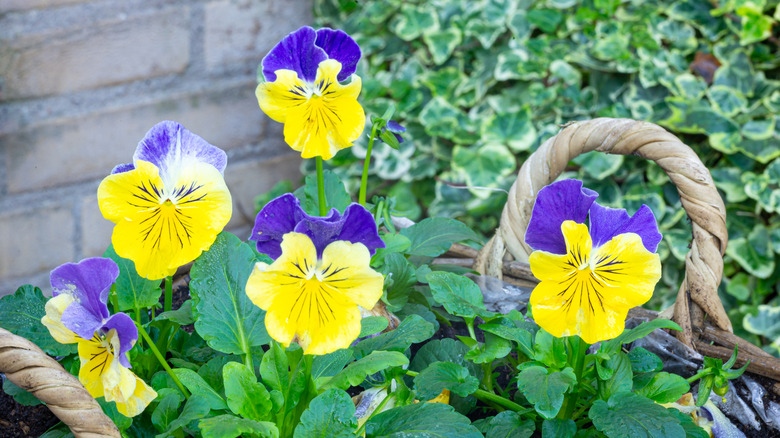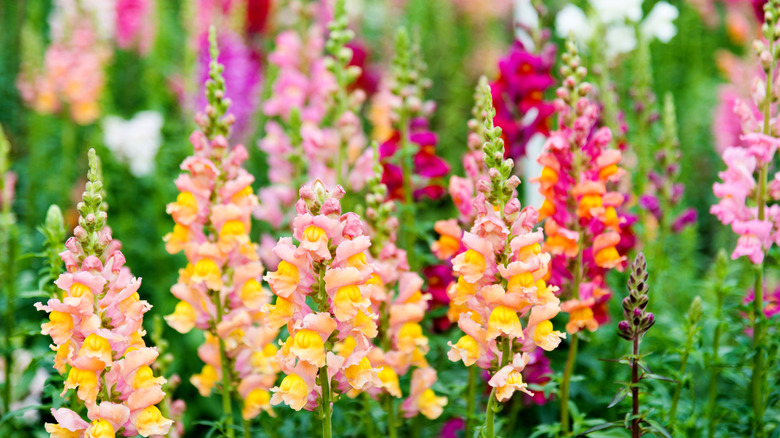12 Plants You Should Always Deadhead In The Fall For A Final Flush Of Flowers
Autumn-blooming plants are a salve to gardeners who are struggling to cope with the prospect of a lifeless, barren fall, especially after a vibrant and successful summer. In fact, some surprisingly colorful plants continue to thrive when the mercury begins to drop, bringing the kind of colors to your yard that would strike envy into even your most green-fingered neighbors. As with many flowering plants, deadheading can often be the difference between a plant that simply exists and one that positively thrives.
In many cases, deadheading is paramount to ensuring your plants continue to flower. This is because, generally speaking, flowering marks the end of a plant's life cycle (be it a perennial or annual). In the case of annuals, it is their swan song — their final act before they produce seed and die. By snipping away the flower heads when they begin to fade, you can effectively trick your plant into thinking it needs to push more flowers out to do what it's adapted to do: seed itself.
This is true of many plants, and while you may associate the deadheading process with summer (since this is when many of your favorite flowers are likely to come into bloom), it's just as important for several autumn-flowering species. Depending on the varieties growing in your garden, the process can extend the blooming season of your plants and help you control their spread by preventing re-seeding. For any avid gardener, there's much to be said for deadheading flowers in the fall.
Chrysanthemums (Chrysanthemum spp.)
Hardy in zones 5 to 9, chrysanthemums (Chrysanthemum spp.) bloom in an array of colors. They're especially popular among gardeners who want to ensure their gardens remain redolent of summer through the cooler months of fall. In fact, certain types will flower until December, making them an attractive prospect for anyone not yet ready to say farewell to the colors of summer.
Whether you want to maximize their effect in your garden borders or give yourself a plentiful supply of long-lasting cuttings for the kitchen table, there are a few things you need to do to help your mums thrive, and that includes deadheading. Not only will doing so help keep the plant looking neat and tidy, but it'll also promote a continued abundance of blooms. Later in the season, when they begin to fade for the final time (provided they're a perennial type), it's recommended to cut the stems back to approximately 4 inches high. This, along with an insulative layer of mulch, will help your plants survive the winter, leaving them in fine fettle for renewed growth the following spring.
Dahlias (Dahlia spp.)
Bringing rainbow hues and myriad shapes to flower beds, borders, and container gardens, dahlias (dahlia spp.) are one of the most reliable perennials to grow for an autumn bloom. Despite being native to Central America, they can nevertheless be grown, albeit as annuals, in hardiness zones 7 and below.
Like many other flowering plants, weekly deadheading into the autumn months will help these determined dazzlers to push out as many flowers as possible. Just note that it's important not to push your luck for too long. Given their tenderness to frost, if you live in a zone that experiences freezing temperatures, you should carefully dig up the tubers and store them indoors to protect them against the elements. Consider doing the same if you live in an area that experiences a lot of winter rainfall; while dahlia plants can be successfully overwintered in the ground in zones 8 to 10 (provided they're cut back to the ground and mulched), excessive rainfall is likely to penetrate the tubers' thin skins, which can lead to rot.
Geraniums (Pelargonium spp.)
There are many reasons to plant geraniums (Pelargonium spp.) in your garden, especially if you want to get the most bang for your buck. They have a long blooming season that starts in the spring and often runs into the fall, and in certain conditions, geraniums may even continue to flower into winter.
Like most plants, you don't have to keep your shears sharp to keep your geraniums healthy. Just as they would if growing naturally, they'll cope just fine in your garden without deadheading. However, by lopping off flowers when they're spent, you can help increase flower production throughout the fall and even extend the blooming season.
Known as "tender geraniums," as opposed to "true" geraniums (which are generally considered hardy and reliable perennial plants), pelargoniums are mostly grown as annuals. They are hardy in zones 9 to 12, but in cooler climates, they will likely die back once frost begins to set in, leaving you with two options. You can continue to deadhead your pelargoniums until they've had enough of the cold, before pulling them out and adding them to the compost heap. Or, you can overwinter them indoors by carefully removing them from the ground ahead of the first fall frost, potting them, and storing them in a spot with plenty of sunshine.
Asters (Aster spp.)
Abundantly colorful at a time when gardeners need it most, these popular fall bloomers bring daisy-like vibes to gardens across zones 3 to 8. They produce "profusions" of flowers, which means that deadheading isn't strictly necessary to ensure an abundant show. But that doesn't mean that it's not worth sharpening your snips.
Deadheading asters (Aster spp.) can encourage your plants to focus their energy on flower production, rather than trying to keep spent flowers going. As for how long to deadhead, it depends on when your area receives its first frost. In other words, keep going until the temperatures start to freeze. At this point, it's up to you whether to trim away the final flowers.
Asters will take the first frost as a strong hint that it's time to stop flowering, and as the final flourish wilts, the seedy flowers will provide both food and shelter for birds and other wildlife. Of course, given that certain types of aster can self-seed, failing to deadhead at this stage could leave you with more flowers than you bargained for next year. With that in mind, you may wish to remove the flowers ahead of the winter and, once the foliage has started to brown, prune the plant back to a few inches above the ground.
Daylilies (Hemerocallis spp.)
Known for their rapid production of colorful blooms, certain types of daylilies (Hemerocallis spp.) can continue flowering into the fall, making them a boon to budding botanists who are tearing their hair out as their summer gardens fall fallow. Generally speaking, their flowering period is short compared to others on this list — often only up to five weeks — and exactly when they'll start to bloom depends largely on your hardiness zone (they can be grown in zones 3 to 9). When the time comes, however, it's worth keeping your shears on hand, as deadheading daylilies is well worth it.
For "reblooming" types, like the whimsically-named 'Raspberry Frolic' (Hemerocallis 'Raspberry Frolic'), deadheading will encourage them to keep shooting new flowers. For other types, while deadheading may not encourage more flowering than the plant would otherwise be in the mood for, you can nevertheless ensure it remains tidy. A fastidious approach will also help to mitigate and control hemerocallis gall midge — a pest that can cause buds to drop off the plant before they even have a chance to open.
Garden phlox (Phlox paniculata)
Yielding prized displays of radiant, fragrant flowers, garden phlox (Phlox paniculata) will bring color to your borders from summer and into early fall. It'll do so year after year, too, provided that you live between hardiness zones 4 and 8.
Deadheading can help to encourage a second bloom later in the season, keeping your garden awash with color when it most needs it. It can also prevent your plants from self-seeding. This is important, since garden phlox seedlings are often inferior to their parents, which are produced asexually (that is, from cuttings rather than seed). Self-seeded phlox can give your borders a weedy look if allowed to freely germinate.
Once the growing season has come to a close, it's advised that you prune your garden phlox right back to ground level. This may seem harsh — unfair, even — but your plants will actually thank you for it, returning the following season with vigor and a renewed will to wow you with color.
Black-eyed Susans (Rudbeckia hirta)
Black-eyed Susans (Rudbeckia hirta) are one of the most popular members of the radiant Rudbeckia family, and it's no wonder. They're unafraid of the winter temperatures usually experienced in zones 3 through 9, and promise to bring sunny hues of orange and yellow to gardens from summer and into the fall.
Their vibrant petals contrast beautifully with their black seed hearts, and provided that you continue to deadhead them during the blooming season, they'll do their utmost to keep the show going. More than that, while those aforementioned sunburst colors are hard to get enough of, black-eyed Susans are pretty nifty when it comes to self-seeding. In other words, if you neglect to snip away your plants' final flourish of flowers at the end of the year, you could well find yourself with more Susans than you're comfortable with the next year.
Campanula bell flowers (Campanula spp.)
Mostly growing in zones 4 to 8, there are many different types of Campanula bell flowers (Campanula spp.) to choose from for those seeking a fall-time flush of color. Generally speaking, most of them benefit from a consistent deadheading regimen, which will encourage them to keep the flowers coming. Certain types, like Campanula 'Iribella,' will flower all the way until October, doing so more abundantly provided that you keep your shears sharp.
The reason it works, as is true for many other flowering plants, is that removing the spent blooms enables the plant to reroute its energy back into flower production, rather than using it to turn faded flowers into seeds. Of course, the blooming season won't last forever. Keep deadheading your plant for as long as it produces new flowers, and when it stops, give it a good prune. Cutting it back to ground level will help prepare it for winter dormancy and ensure it's fighting fit to grow back the following year.
Dianthus (Dianthus spp.)
With an array of species that can grow anywhere between zones 3 and 10, depending on your chosen type, dianthus (Dianthus spp.) are known and loved for being easy to grow, fabulously fragrant, and even edible. Many types also have a long flowering season, blooming from spring all the way until October and bringing often-astonishing colors to fall gardens long after the mercury starts to drop.
Deadheading only improves this bolshy determination to bloom despite the decreasing temperatures, so if you have a fall-flowering variety, be sure to keep your eye on the flowers and trim away those that are starting to fade. This will help ensure you keep the growing season going for as long as possible. When the good times finally come to a close — usually after your area's killing frost — a hard prune to a couple of inches above ground level will help the plant weather the winter.
Shasta daisies (Leucanthemum x superbum)
This clump-forming perennial does well across zones 4 to 9, bedazzling gardeners in high contrast thanks to a dark green foliage that underscores its snowy white, yellow-hearted flowers. The flowers that earn this plant its status as a daisy also make it a stunning border addition for attracting pollinators, and provided that you know how to care for shasta daisies, they'll continue to bloom for years to come.
It's tempting to leave the pollinator-friendly flowers in place. After all, why risk ruining a good thing? However, regular deadheading can help to prolong their blooming season, which can run from summer into early autumn. When they finally finish flowering, pruning can be prudent to help them ride out the winter. Just look out for the rosettes of basal leaves that form toward the base of these plants; these usually occur late in the season and shouldn't be disturbed. Instead, cut off your daisy stalks above this new growth, leaving it in place to help the plant spring back after winter.
Pansies (Viola tricolor var. hortensis)
Generally growing in milder climates between hardiness zones 6 and 10, pansies (Viola tricolor var. hortensis) will gladly gild your borders with color through the autumn months, often continuing into the winter. As with many other flowering species, deadheading during this period ensures production is as prolific as possible, for as long as possible. It'll also keep your plant looking neat and at its best, rather than beleaguered and in need of a rest.
When left in place, pansy flowers draw on the plant's finite stores of energy in order to develop seed pods, effectively channeling energy away from flower production. This means that if you miss a few days and start to notice seed pods forming, it can pay to snap them off. This is especially true if you want to prevent your pansies from self-seeding and overcrowding your flower beds.
Snapdragons (Antirrhinum majus)
Blooming into October, snapdragons (Antirrhinum majus) thrive in hardiness zones 7 to 10, where their fall flourishes bring life to gardens that are beginning to say goodbye to the colorful bounty of summer. They're also a beginner-friendly plant for attracting pollinators, representing an easy win for those who are new to the nuances of gardening, yet want to improve biodiversity in their back yards.
Once they start to flower, deadheading will encourage these plants to keep blooming for as long as the weather remains conducive. It will also help to keep your plants tidy, and by pinching away the flowers, you'll have a plentiful supply with which to fill your favorite vase.
Snapdragons often bloom twice in the year, once from spring and into summer, and then from summer into fall. For the best chance of color in the autumn, aim to deadhead after the year's first flushWhen allowed to go to seed (that is, when their flowers aren't trimmed away), these plants will complete their life cycles and cease all flower production. If allowed to seed, you may also find that they spread beyond their allotted area, leading to a surprise the following spring.
